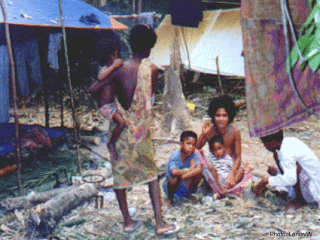www.iias.nl/nl/35/IIAS_NL35_10.pdf - Similar
Orang Asli land is coveted by powerful interests: for its timber and minerals, for conversion into oil palm or rubber plantations, golf courses, hydroelectric power installations, the Kuala Lumpur International Airport and development projects to benefit the other majority population.
The reasons behind Orang Asli relocation or displacement are often concealed from the public eye. Instead, for the Orang Asli, displacement is called development.Government policies aim to draw them into ‘the mainstream of society’, into the ‘right’ place and time. But the recent court awards to the Orang Asli in Selangor gave the Orang Asli rights over rights on land.
The ethnic label Orang Asli, meaning ‘natural people’ in Malay, replaced the term ‘aborigines’ used by the British colonial administration. Orang Asli refers to the indigenous peoples of Peninsular Malaysia who are not Malay Muslims, Malaysia’s main ethnic group.The Orang Asli, together with the Malays and indigenous peoples of Sabah and Sarawak, form the category of Malaysians known as bumiputera (‘sons of the soil’) who make up 65.1 per cent of the population.
The Orang Asli comprise 0.5 per cent of the population and are conventionally divided into eighteen ethno-linguistic subgroups. Both ethno-labels – bumiputera and Orang Asli – imply indigenous; Malays are classified as bumiputera but not as Orang Asli. Occasionally, opposition politicians raise questions about indigeneity and rights of indigenous minorities but these are quickly stifled by the ruling party, the United MalaysNational Organisation (UMNO). When questioned by the media, Malaysia’s first Prime Minister Tunku Abdul Rahman replied, ‘there is no doubt that the Malays were the indigenous peoples of this land because the original inhabitants did not have any form of civilisation compared with the Malays…and instead lived like primitives in mountains and thick jungle’
There is no doubt that Orang Asli ancestors settled on the ‘Malay’ Peninsula long before the predecessors of contemporary Malays. However, prior settlement does not accord the descendants political privileges. The musings of the former Prime Minister, Dr Mahathir Mohamad, are revealing: ‘Aborigines are found in Australia, Taiwan and Japan…but nowhere are they regarded as the definitive people of the country concerned. The definitive people are those who set up the first governments….In Malaya, the Malays without doubt formed the first effective governments….The Orang Melayu or Malays have always been the definitive people.
| Orang Asli population by groups and subgroups (2000)[3] | |||
| Negrito | Senoi | Proto Malay | |
|---|---|---|---|
| Bateq (1,519) | Chewong (234) | Jakun (21,484) | |
| Jahai (1,244) | Jah Hut (2,594) | Orang Kanaq (73) | |
| Kensiu (254) | Mah Meri (3,503) | Orang Kuala (3,221) | |
| Kintaq (150) | Semai (34,248) | Orang Seletar (1,037) | |
| Lanoh (173) | Semaq Beri (2,348) | Semelai (5,026) | |
| Mendriq (167) | Temiar (17,706) | Temuan (18,560) | |
| 3,507 | 60,633 | 49,401 | |
| Total: 113,541‡ | |||
The poverty rate among Orang Asli is 76.9%.[1] In addition to this high rate, the Statistics Department of Malaysia has classified 35.2% of the population as being "hardcore poor". The majority of Orang Asli live in rural areas, while a minority have moved into urban areas. In 1991, the literacy rate for the Orang Asli was 43% compared to the national rate of 86% at that time.[1] They have an average life expectancy of 53 years (52 for male and 54 for female). A high infant mortality rate is also evident with 51.7 deaths per 1000 births.[6]
See also: Demographics of Malaysia
Why Orang Asli becomes a attentive real issue now in the bye-election of Galas and Batu Sapi especially in Galas, where the Orang Asli votes would be vital in winning or losing so here presents about the real issues of Orang Asli and why after 53 years of independence the Orang Asli are still in the dark and back stage of development but becomes the focal points of politicians but after the elections they will be just another issue come and gone as the last 53 years have shown.
Sifu have been and seen a number of these settlements way back in the 70's and the scenes now is of little different but the social problems is magnitude then and now its only the elections giving them hopes and fruits to enjoy but they will be forgotten till the next election.











No comments:
Post a Comment